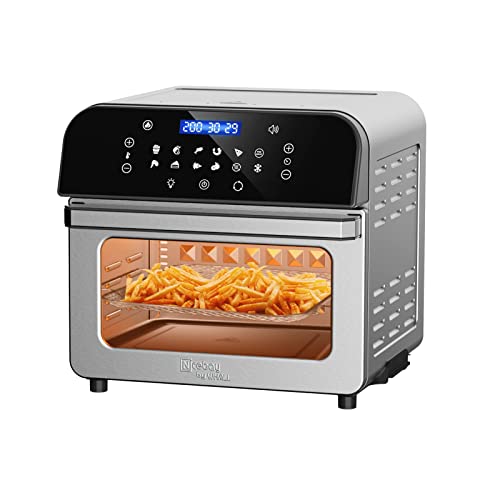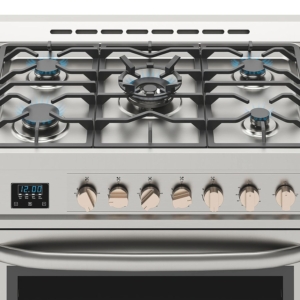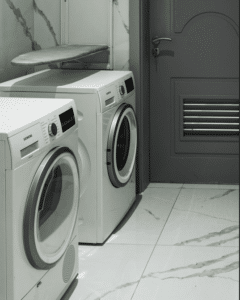A Beginner’s Guide to Convection Cooking:
What You Need to Know

Ever wondered how to make your meals tastier and healthier? Well, convection cooking might be the perfect answer. This cooking method, once a mystery to many, is now gaining popularity in kitchens around the world. With its ability to cook food evenly and quickly, it’s no wonder why people are trading in their traditional ovens for a convection one. But what is convection cooking, exactly? In a nutshell, it’s a method that uses a fan to circulate hot air around food, resulting in evenly cooked meals that are juicier and more flavorful. This blog post will shed light on everything you need to know about convection cooking, starting from the basics. If you’re a beginner, don’t worry; this guide is meant for you. By the end, you’ll have all the knowledge you need to start using this method in your own kitchen. So, let’s dive in and explore the world of convection cooking.
What is Convection Cooking?
Definition and Explanation
Convection cooking is a cooking technique that utilizes the power of hot air circulation to cook food evenly and quickly. Unlike conventional cooking methods that rely solely on radiant heat, convection cooking employs the use of a fan and exhaust system to circulate the hot air throughout the oven cavity. This constant movement of hot air ensures that the food is cooked uniformly, resulting in delicious and perfectly cooked dishes.
How Convection Cooking Works
Now that we have a basic understanding of what convection cooking is, let’s dive into how this technique actually works. As mentioned earlier, convection cooking relies on the circulation of hot air within the oven.
When you turn on the convection feature in your oven, the fan located at the rear or top of the oven cavity starts to spin. This fan draws in the cool air from the kitchen, passes it through a heating element, and then distributes the hot air back into the oven. The hot air is evenly dispersed, creating a constant and uniform temperature throughout the cooking process.
The movement of hot air has several benefits. Firstly, it helps to eliminate any hot or cold spots within the oven, ensuring that food is cooked evenly from all sides. This means no more worrying about unevenly baked cookies or burnt edges on your casseroles.
Secondly, the circulation of hot air speeds up the cooking process. Since the hot air is constantly in motion, it transfers heat more efficiently to the food. This means that you can often reduce the cooking time required for your recipes, making convection cooking a time-saving option.
Lastly, convection cooking is great for achieving that coveted crispy texture on the outside of your dishes. The continuous flow of hot air helps to remove moisture from the food’s surface, resulting in a crispy and golden crust on baked goods or a perfectly seared exterior on meats.
Benefits of Convection Cooking
Convection cooking is a popular cooking method that utilizes the power of circulating hot air to cook food faster and more evenly. This section will explore the various benefits of convection cooking, including faster cooking times, even heat distribution, and better browning and crisping.
Faster Cooking Times
One of the primary advantages of convection cooking is its ability to reduce cooking times significantly. By using a fan to circulate hot air around the food, convection ovens create a more efficient cooking environment. The hot air surrounds the food from all sides, allowing it to cook more quickly and evenly. This means that you can prepare your favorite dishes in less time, helping you save valuable minutes in the kitchen.
Even Heat Distribution
Another remarkable benefit of convection cooking is its ability to distribute heat evenly throughout the oven. Traditional ovens rely on radiant heat, which can result in hot spots and uneven cooking. In contrast, convection ovens use a fan to circulate the hot air, ensuring that every corner of the oven receives the same amount of heat. This even heat distribution guarantees that your food cooks uniformly, eliminating the risk of undercooked or overcooked areas. Whether you’re baking a cake or roasting a chicken, you can trust that convection cooking will deliver consistent results.
Better Browning and Crisping
Craving that perfect golden-brown crust on your baked goods or a crispy exterior on your roasted meats? Convection cooking excels at achieving precisely that. The circulating hot air in a convection oven helps to create a drier cooking environment, allowing the surface of your food to brown and crisp more effectively. This is particularly beneficial when it comes to roasting meats or baking pastries, as convection cooking can give your dishes that desirable texture and appearance. Say goodbye to soggy bottoms and hello to beautifully browned, crispy creations!
By harnessing the power of convection cooking, you can enjoy faster cooking times, even heat distribution, and better browning and crisping in your culinary adventures. Whether you’re a seasoned chef or a beginner in the kitchen, incorporating convection cooking into your repertoire can elevate your cooking game to new heights. So go ahead, embrace the benefits of convection cooking, and let your taste buds rejoice in the delicious results.
A Beginner’s Guide to Convection Cooking: What You Need to Know
Convection Oven vs. Traditional Oven
Key Differences
To start, let’s delve into the key differences between convection ovens and traditional ovens:
- Heating Method: In a traditional oven, heat is generated from the bottom or top heating elements, radiating heat throughout the oven cavity. On the other hand, convection ovens feature a fan that circulates hot air evenly around the food, resulting in faster and more even cooking.
- Cooking Time: Due to the circulation of hot air, convection ovens cook food faster than traditional ovens. This can be a time-saving advantage, particularly when you are in a hurry or cooking large quantities.
- Temperature Control: Traditional ovens often have hot spots, causing uneven cooking. Convection ovens, however, provide more even heat distribution, reducing the likelihood of overcooking or undercooking certain areas of your dish.
- Energy Efficiency: Convection ovens generally require less energy to operate compared to traditional ovens. The efficient airflow and reduced cooking time contribute to lower energy consumption, making them a greener option.
- Cookware Compatibility: While most cookware is suitable for both types of ovens, convection ovens may require adjustments in cooking time and temperature. It is essential to follow the manufacturer’s guidelines and experiment with your recipes to achieve optimal results.
Which One Should You Choose?
The decision between a convection oven and a traditional oven ultimately depends on your cooking preferences and needs. Consider the following factors to help you make the right choice:
- Cooking Style: If you frequently bake or roast, a convection oven can be a game-changer. The even heat distribution helps achieve consistent browning and crispiness, making it ideal for pastries, roasts, and casseroles. However, if you primarily use your oven for simple tasks like reheating leftovers or making pizzas, a traditional oven may suffice.
- Time Considerations: If you value efficiency and shorter cooking times, a convection oven is an excellent option. It can significantly reduce the time required to cook your favorite dishes, allowing you to enjoy them sooner.
- Energy Efficiency: If you are conscious of your energy consumption or want to reduce your utility bills, a convection oven is a more energy-efficient choice. The reduced cooking time and even heat distribution contribute to energy savings in the long run.
- Budget: Convection ovens often come at a higher price point than traditional ovens due to their advanced features. Consider your budget and whether the benefits of a convection oven outweigh the additional cost for your cooking needs.
Tips for Using a Convection Oven
Adjusting Cooking Times and Temperatures
- Reduce the cooking time: As a rule of thumb, you can decrease the cooking time by about 25% when using a convection oven. Keep a close eye on your food, especially during the first few uses, to avoid overcooking.
- Lower the temperature: Lowering the temperature by about 25 degrees Fahrenheit (or 15 degrees Celsius) is a good starting point. This adjustment compensates for the efficient heat circulation in a convection oven.
- Use a thermometer: To ensure your food is cooked to perfection, invest in a reliable food thermometer. This way, you can monitor the internal temperature and guarantee that meats are cooked thoroughly and baked goods are perfectly done.
Positioning and Airflow
Proper positioning and understanding the airflow in a convection oven are crucial to achieving optimal cooking results. Consider the following tips:
- Leave space for airflow: To allow the hot air to circulate effectively, make sure there is enough space around your baking dishes or pans. Crowding the oven can disrupt the airflow and result in uneven cooking.
- Use low-sided pans: Opt for low-sided pans or baking sheets when using a convection oven. This type of cookware allows the hot air to reach the food more easily, promoting even browning and crispiness.
- Rotate the pans: To ensure even cooking, consider rotating the pans halfway through the cooking time. This step helps to compensate for any potential hotspots in the oven.
Cookware and Bakeware Recommendations
Choosing the right cookware and bakeware is essential when using a convection oven. Consider the following recommendations:
- Use lighter-colored pans: Lighter-colored pans reflect heat more efficiently, resulting in better browning and preventing potential burning.
- Avoid using glass cookware: Glass cookware can hinder the convection process by blocking the airflow. It’s best to opt for metal pans or dishes instead.
- Use rimmed baking sheets: Rimmed baking sheets are ideal for roasting meats or baking dishes that contain liquids or sauces. The raised edges prevent any potential spills or drips from causing a mess in your oven.
Common Mistakes to Avoid in Convection Cooking
Convection cooking is a fantastic way to enhance your culinary skills and create delicious meals. However, like any cooking method, there are common mistakes that beginners often make. By understanding these mistakes and how to avoid them, you can ensure that your convection cooking experience is a success.
1. Overcrowding the Oven
One of the most important things to remember when using a convection oven is to avoid overcrowding it. Convection cooking relies on the circulation of hot air to cook food evenly and efficiently. When you overcrowd the oven, you inhibit the air flow, resulting in uneven cooking.
To avoid this mistake, make sure there is enough space between your food items to allow the hot air to circulate freely. It’s better to cook in multiple batches if necessary rather than overcrowding the oven and compromising the quality of your dishes.
2. Not Adjusting Recipes
Another common mistake in convection cooking is failing to adjust recipes. Convection ovens cook food faster than conventional ovens due to the circulating hot air. As a result, you need to make adjustments to the cooking time and temperature specified in your recipes.
To ensure the best results, reduce the cooking temperature by about 25 degrees Fahrenheit and decrease the cooking time by approximately 25%. Keep an eye on your food while it cooks and use a reliable oven thermometer to ensure accuracy.
3. Neglecting to Preheat
Preheating the oven is crucial in convection cooking, yet it’s a mistake that often goes unnoticed. Preheating allows the oven to reach the desired temperature before you start cooking, ensuring even heat distribution from the beginning.
To avoid this mistake, always preheat your convection oven for at least 10-15 minutes before placing the food inside. This simple step will help you achieve consistent and reliable cooking results.
Remember, practice makes perfect, so don’t be discouraged if you make mistakes along the way. Embrace the learning process and keep experimenting with new recipes to master the art of convection cooking. Happy cooking!
Frequently Asked Questions about Convection Cooking
Can I Use Convection for Baking?
Absolutely! Convection cooking is excellent for baking, as it provides even heat distribution, resulting in perfectly browned and evenly cooked baked goods. The circulating hot air in a convection oven helps to eliminate hot spots and ensures that your cookies, cakes, and breads are baked to perfection.
To use convection for baking, you may need to make a few adjustments. It is recommended to lower the oven temperature by about 25 degrees Fahrenheit (or 15 degrees Celsius) when using the convection setting. This slight reduction in temperature helps to prevent over-browning and ensures that your baked goods are cooked evenly.
Can I Use Convection for Roasting?
Yes, convection cooking is fantastic for roasting meats, vegetables, and more! The even heat distribution in a convection oven helps to seal in the juices and create a crispy exterior while keeping the inside tender and moist.
When using convection for roasting, it is best to use a roasting pan with low sides to allow the hot air to circulate around the food. This helps to promote even browning and ensures that your roast cooks evenly. You may also need to adjust the cooking time slightly, as convection cooking tends to be faster than conventional cooking methods.
Do I Need to Make any Adjustments to My Recipes?
In most cases, you will need to make some adjustments to your recipes when using a convection oven. The circulating hot air can affect cooking times and temperatures, so it’s essential to understand how to adapt your recipes for convection cooking.
As mentioned earlier, when baking, it is recommended to lower the oven temperature by about 25 degrees Fahrenheit (or 15 degrees Celsius). Additionally, you may need to reduce the cooking time slightly, as convection cooking tends to be faster than conventional cooking methods. It’s always a good idea to keep an eye on your food and use a reliable oven thermometer to ensure it is cooked to perfection.
For roasting, it is generally recommended to keep the temperature the same as the recipe suggests but reduce the cooking time by about 25%. Again, it’s crucial to monitor your food closely to avoid overcooking.
A Beginner’s Guide to Convection Cooking: What You Need to Know
Cleaning and Maintenance Tips for Convection Ovens
Regular Cleaning Practices
To maintain a clean and efficient convection oven, it is important to establish regular cleaning practices. By incorporating these simple steps into your routine, you can prevent the buildup of grease, food particles, and other debris that may affect the oven’s performance.
- Wipe down the interior: After each use, take a damp cloth or sponge and wipe down the interior surfaces of the oven. This will help remove any food residue or grease that may have accumulated during cooking.
- Clean the racks: Remove the oven racks and soak them in warm soapy water. Use a gentle brush or sponge to scrub away any stubborn stains or residue. Rinse the racks thoroughly and allow them to dry completely before placing them back into the oven.
- Clean the exterior: Don’t forget to clean the exterior surfaces of your convection oven as well. Use a mild detergent and a soft cloth to wipe away fingerprints, spills, and other marks. Avoid using abrasive cleaners or scrubbing brushes that may damage the oven’s finish.
- Replace foil liners: If you use foil liners on the bottom of your oven to catch drips, be sure to replace them regularly to prevent the accumulation of grease and debris.
By following these regular cleaning practices, you can maintain a hygienic and functional convection oven.
Deep Cleaning and Maintenance
In addition to regular cleaning, deep cleaning and maintenance should be performed periodically to ensure optimal performance and longevity of your convection oven. Here are some steps to consider:
- Self-cleaning function: Many modern convection ovens come with a self-cleaning function. This feature uses high temperatures to burn off any food residue or grease, leaving behind only ash that can be easily wiped away. Follow the manufacturer’s instructions to safely and effectively use this function.
- Removing stubborn stains: For stubborn stains or food residue that cannot be removed with regular cleaning methods, you can use a mixture of baking soda and water. Apply the paste to the affected areas, let it sit for a while, and then scrub gently with a sponge or brush.
- Check and clean the fan: The convection fan is responsible for circulating the hot air inside the oven. Over time, it can accumulate dust and debris, affecting its performance. Regularly check the fan and clean it using a soft brush or vacuum cleaner to ensure it operates smoothly.
- Inspect the seals: The oven door seals are crucial for maintaining proper temperature and energy efficiency. Regularly inspect the seals for any signs of damage or wear. If you notice any gaps or leaks, replace the seals to prevent heat loss and uneven cooking.
Conclusion
Convection cooking is a game-changer in the world of culinary arts. By understanding the basics of convection cooking, you can elevate your cooking skills and create delicious meals with ease. Remember to preheat your oven, adjust cooking times and temperatures, and use the right cookware for the best results. Convection cooking offers even heat distribution and faster cooking times, making it a fantastic option for busy individuals or anyone looking to explore new cooking techniques. With this beginner’s guide, we hope you now have the knowledge and confidence to embark on your convection cooking journey. So go ahead, experiment with new recipes, and enjoy the many benefits that convection cooking has to offer!







